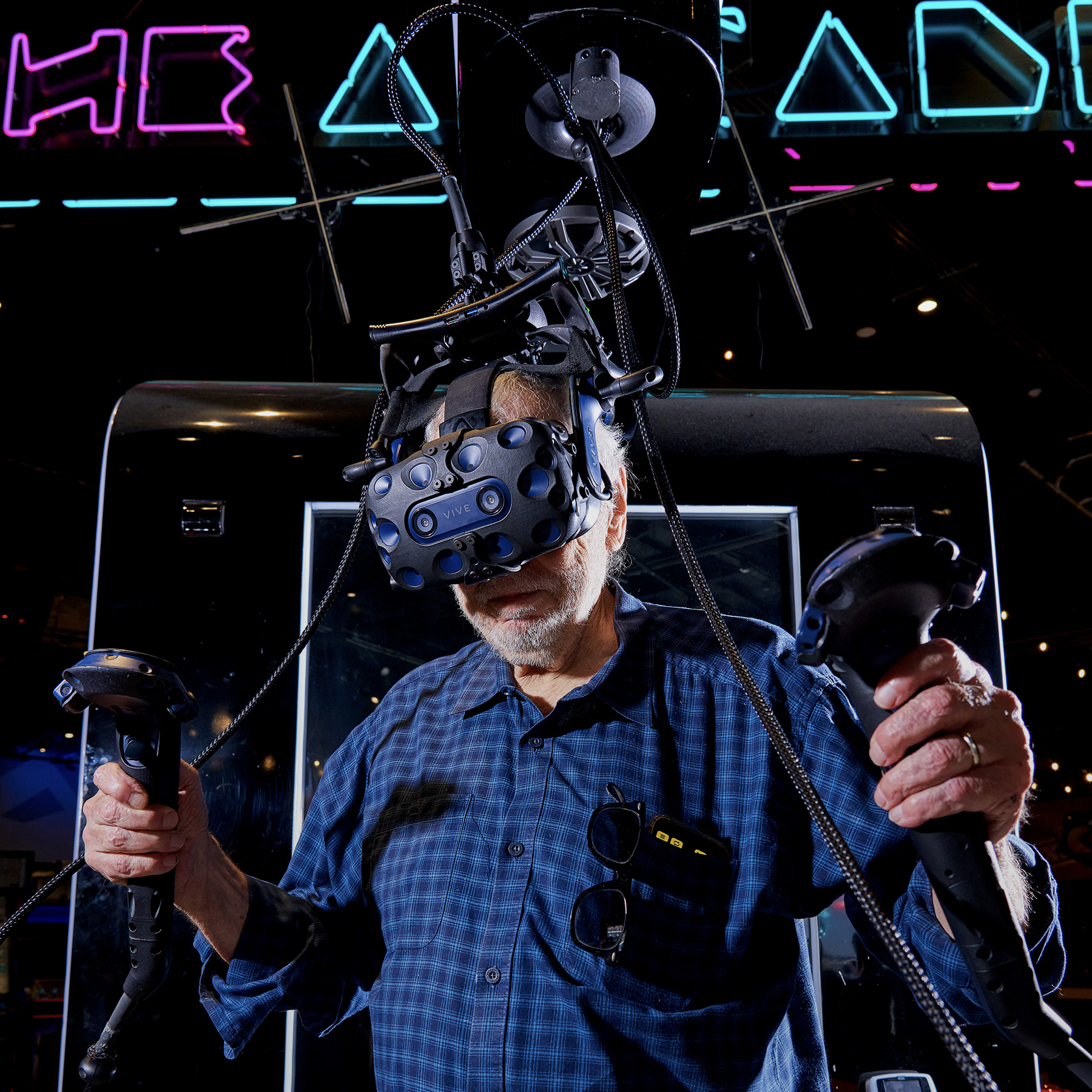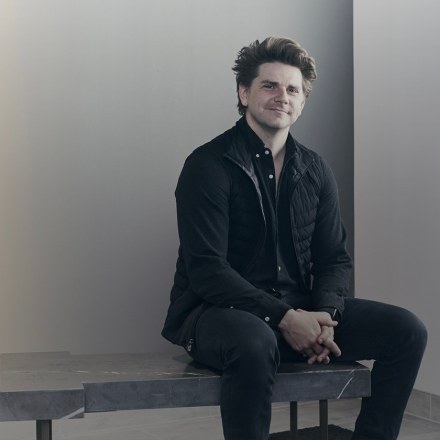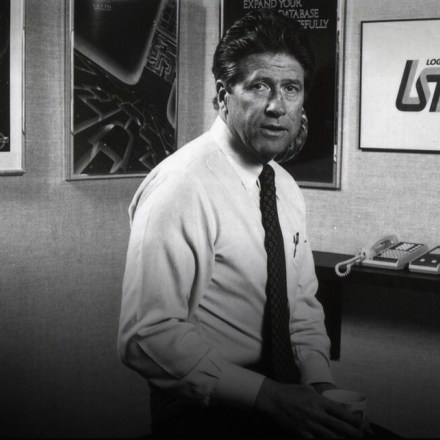Nolan Bushnell needs no introduction. When he arrives at Two Bit Circus in downtown Los Angeles, I recognize him as soon as he steps out of his car: the grandfatherly goofball with a shock of white beard, tall and casual in a baseball cap and sneakers.
“I’m so sorry about last time,” he says, referring to the first time we tried to meet and his daughter told me he had just tested positive for covid-19. I demur and follow him into the building where we will conduct our interview.
It is a warehouse filled with gaming stations, baroque furniture, art installations and other sensory stimulants. A life-size Hungry Hungry Hippos awaits players—children and child-like grownups alike—next to massive arcade booths kitted out with dozens of colorful buttons and knobs, their screens still dark as Two Bit Circus prepares to open to the public for the afternoon. An inanimate horse’s rear end from a merry-go-round, gaudily painted in red and gold, offers a seat from beneath a bar in the middle of the cavernous space.
Bushnell’s son, Brent, opened Two Bit Circus in 2018, drawing on a penchant for fun that runs in the family. As the founder of Atari, the elder Bushnell popularized one of the most enduring tools of entertainment-based escapism in history: the video game. Long before that, though, an amusement park job he held in college introduced him to the thrill of selling fun. He loved the role—a true duck-in-water experience that saw him “always just massacring quota,” as he describes it.
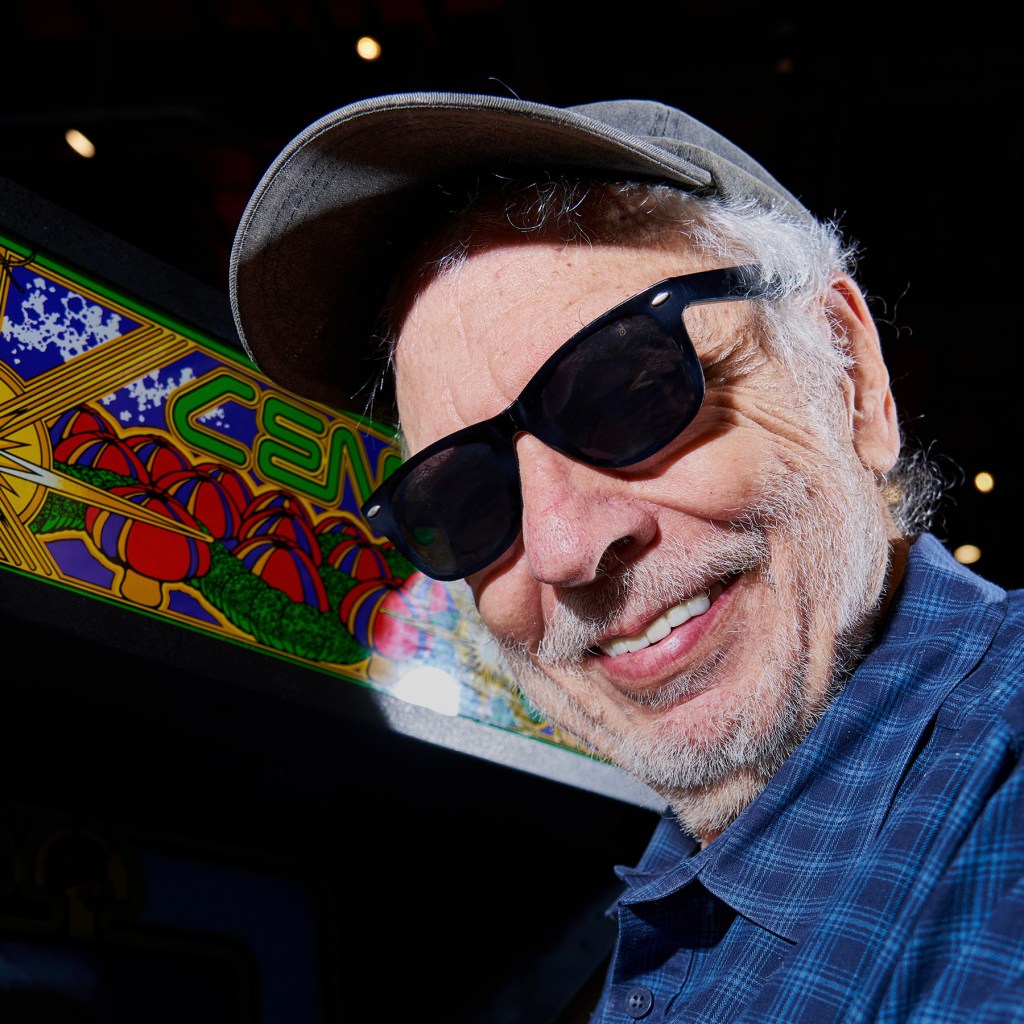
Going with the flow state
Much of the opportunity for the tech-enabled exploration that fed Bushnell’s instincts arose by happenstance. The military, a big presence in the suburban Utah community of Bushnell’s youth, regularly discarded heaps of kit that Bushnell and his friends would purloin. His neighbor ran a surplus store “full of neat shit.” All this opened a world of machines for him, to the extent that by age ten, he was timing the emergence of sunspots in order to open communication lines over his self-built radio to Japan.
“In junior high school science and physics, I often knew more than the teacher did, and I was not always nice about it,” he laughs.
Yet even amid the explosion of technological innovations taking place in the early 1950s, a career as an entrepreneur was hardly a preordained path. The customary route for technologists during Bushnell’s formative years involved working for the government or a large company. But Bushnell felt his first entrepreneurial itch selling strawberries for his mother at age six. At ten, he repaired TVs, figuring out how to acquire replacement parts and mark them up for less than professionals in the yellow pages while still making a big profit by adolescent terms. “I always disdained the thought of selling time for money,” he says.
It helped that Bushnell felt a profound sense of fulfillment from all this tinkering. Without knowing it, he would enter a “flow state”—also known as being “in the zone”—which holds that when a task is “hard, but not overwhelming, achievable, but not frustrating or boring,” in Bushnell’s words, the brain enters a particularly receptive condition.
“Time dilates; you can play for an hour and think it’s 15 minutes,” he says, his gray eyes flashing with excitement as he explains how the flow state has influenced him throughout his life.
The flow state is precisely what happens during intensive gameplay, a fact that Bushnell recognized as the key to creating an empire out of interactive entertainment. What elevates Bushnell’s creations above normal games emerges from something unique to his technologist demographic: the ability to enter that state when constructing hardware, to land on those time-dilating, brain-expanding conditions when cauterizing metal or fiddling with wires. In addition to shockers, as a young man Bushnell also made a ham radio, a speaker phone, a rudimentary neighborhood telephone network and a system of lights on his bedroom ceiling that would illuminate during storms. Later, he would invent the world’s first functional car navigation system a full decade before the advent of GPS.
Quasi-spiritual motivations like the flow state entered Bushnell’s repertoire soon after he moved to Silicon Valley, whose nascent chip industry of the 1960s attracted him. What influenced him yet more, perhaps, was the counterculture taking hold at the time. “I was very influenced by the hippie movement,” Bushnell says. It would lead him to break rules and challenge conventions at Atari in significant ways, compelling him to overcome hurdles that were far bigger than they appear in hindsight: video games, for one, barely existed as an industry. What did pass for an industry was largely stigmatized and consigned to dark corners of dive bars.
“Early on, there was a lot of controversy about video games,” Bushnell says. “Parents didn’t want their kids going anywhere near them; whole countries banned them.”

Prankster in chief
This tide started shifting bit by bit as Pong, Atari’s flagship title, permeated deeper into the world’s cultural fabric. Don Valentine, the storied Sequoia founder, paid several visits to Atari’s Sunnyvale factory amid growing hype around the game before ultimately investing in 1975. The company, under Bushnell’s leadership, was a goofy place: Friday evening beer fests, smoking marijuana at headquarters, even one instance in which Bushnell rented a jet and flew the staff to Disneyland.
Bushnell says much of Atari’s early reputation has been mischaracterized, even though it has had real-world consequences for Bushnell himself: in 2018, activists successfully denied him a prominent video game lifetime achievement award he was slated to receive, accusing him of fostering an environment in Atari at the time that was toxic to women. When I ask him if any employees felt alienated by Atari’s culture back then, Bushnell says, “no, not at all.” And many of Atari’s early female employees have spoken fondly of their experience.
Bushnell reiterates the values of fairness, dignity and camaraderie that he enumerated in a “goals” manifesto published in Atari’s second year. It specifically directed employees to “judge all people on the basis of their skill and contributions, and not tolerate discrimination on the basis of race, color, creed, national origin, sex, appearance or personal life”—something that many companies still struggle with to this day.
A big element of this system was a more outcomes-driven process of evaluations than was common in the corporate world at the time, one that depended on maintaining a sense of play and fun at work. “As a manager in a highly structured environment, when you’re not working directly on the assembly line, it can be hard to get undoctored feedback, to see where the problems are,” Bushnell says. “Injecting this element of fun as a social lubricant can help lower inhibitions to honesty. This leads to better results.”
It can also serve as a potent recruitment tool, as Bushnell learned when he hired Apple founder Steve Jobs into his first corporate role at 19. Atari’s early working culture—shenanigans and all—would ultimately plant the seeds for the kind of agile, quick-pivot, collegial atmosphere that pervades Silicon Valley and has since spread to startup hubs around the world. While some have adapted this into a “move fast and break things” mantra, Bushnell clarifies that he drew the line at anything illegal or unethical.
“We had one colleague who wanted to grow cannabis on company property,” he says. “I thought that was a bridge too far.”
“I feel like all rebels have to have a bit of the prankster within them.”
NOLAN BUshnell
Pranks, on the other hand, were par for the course. In perhaps one of the most famous in technology history, Bushnell convinced a colleague to design the prototype version of Pong by telling him—falsely—that he had secured a contract from General Electric.
“[Pulling pranks] was part of my DNA,” Bushnell says. “I feel like all rebels have to have a bit of the prankster within them.”
Get the best stories from the Sequoia community.
Be my Valentine
Bushnell admits that mastering the business side of running a fast-growing company was a harder slog than inspiring people—or, in some instances, pranking them—to discover amazing ways to manipulate technology. This is where mentors like Don Valentine played a role: Valentine, a former semiconductor executive, filled the hard-nosed, analytical side of Atari in a way that helped power the company both before and after Sequoia’s initial investment.
“Don would always ask me tough questions about the numbers,” Bushnell says. “It became a competitive thing with us—I would cram before board meetings just so Don couldn’t stump me.”
This yin-yang relationship between the two men eventually evolved into a full-fledged friendship (Bushnell even hired Don’s kids to work in his garden). The two stayed close after Bushnell sold Atari to Warner Communications in 1976, and Valentine helped fund Chuck E. Cheese in their post-Atari years. Despite Valentine’s reputation as the more business-focused of the two, he wasn’t above participating in the trappings of startup culture quickly taking shape in Silicon Valley: “After we inked the [funding] deal, he brought an iced-up tub of champagne to the party,” Bushnell gushes.
That funding deal, however, could not have happened without the company passing a major turning point: an agreement by Sears to distribute a home version of Pong in its stores. The arrangement, struck in 1975, came together after a long slog to find a retail partner; both Toys”R”Us and Radio Shack had previously turned them down. Bushnell cites several reasons: the failure of a rival game console, the Magnavox Odyssey, to catch on; jitters over the novelty and uncertainty about a new gaming technology; disagreements over the appropriate price point. Culturally, big-box retailers—Sears included—were a poor fit for Atari’s looser style. In one infamous anecdote, a team of Sears executives walked into Atari’s headquarters wearing starched collars and walked out in t-shirts.
“With Sears, it really came down to one buyer—this guy named Tom Quinn—who believed in us,” Bushnell says. “I really credit him for putting Atari on the map.”
On Atari’s side, manufacturing enough consoles in time to hit the coveted holiday shopping period was a nerve-wracking challenge. Here, Valentine’s influence was indispensable, helping Atari acquire a new factory in order to meet demand. “Don definitely believed in the consumer market to a greater extent than he did the coin-op market,” Bushnell says. Sequoia’s partnership would go on to propel Atari from a niche, if buzzy, game maker into one of the most iconic companies in history.
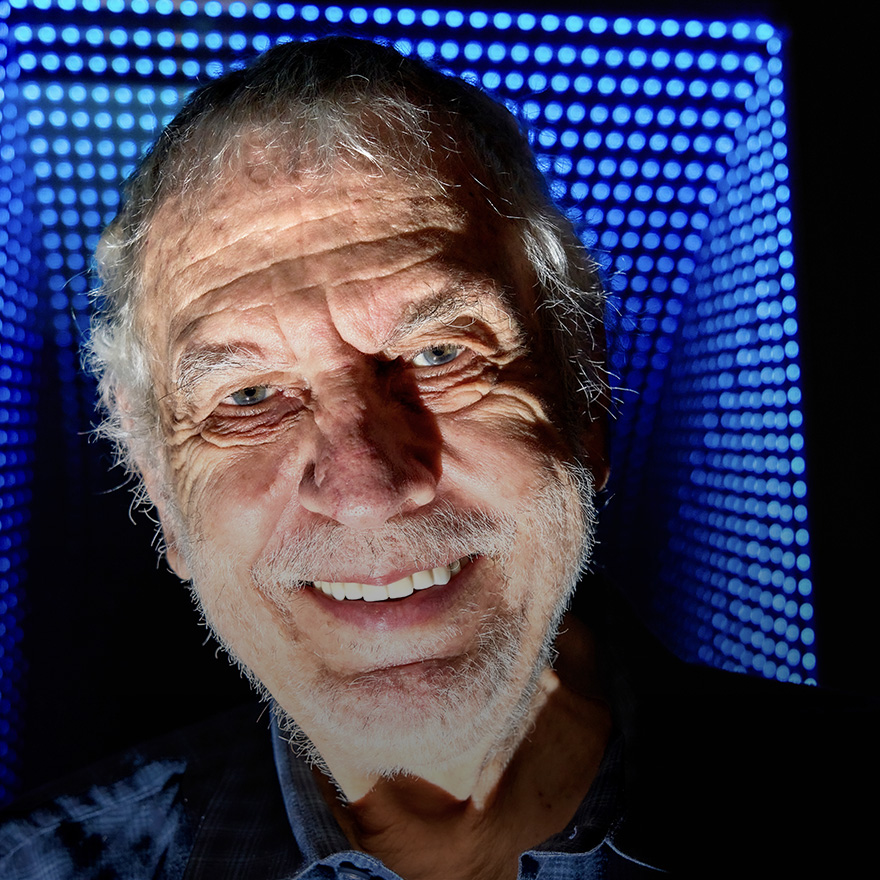
“I’m the kind of person who has a million different ideas, and in my best moments I’ve been lucky to find the right teams to execute them.”
NOLAN BUSHNELL
How to unplug a toilet
An ability to recognize and lean on the capabilities of peers like Valentine—and to take their advice when warranted—is a hallmark of Bushnell’s success, one that he readily confesses to. “I’m the kind of person who has a million different ideas, and in my best moments I’ve been lucky to find the right teams to execute them.” He describes his current role in business as an “activator” who, like the pinball machines dotting the floor of Two Bit Circus, retracts the spring of an inventive concept and lets others flip the paddles. Among other business plans filling his office right now are a wine-and-canapés light show experience and an idea to seed the ocean to increase its carbon-absorption capacity as a means of combating climate change. He has a lot to say about cryptocurrency—mostly positive, although his key takeaway is that “there will be many trials and tribulations before all the shit is sorted out.”
Education remains his biggest piece of unfinished business. He has long concerned himself with the welfare of children—they are, after all, the core audience for his most popular products. Bushnell’s long-held belief that there are better ways to learn than the conventional methods offered by the establishment led him to create ExoDexa, a San Francisco-based startup founded in 2020. ExoDexa’s tools turn classroom curriculum into video games, compelling students to engage with the material in ways they could not in a purely lecture-based environment. In his telling, learning your ABCs should not entail full-time toil; instead, children should be allowed—nay, encouraged—to play, tinker and experiment, just as he did as a youngster. Unsurprisingly, play has always been something he fostered in his own children: his eldest daughter Alissa was an early tester of Pong.
“I’ve been able to maintain my sense of wonder and play through my children,” he says when asked whether the ability to enjoy fun fades with age. He hopes that by centering education around play, he can help disenfranchised youth become “stealth scholars”: kids that feel motivated to improve by competing against themselves rather than seeking better grades than their peers.
“What if I could teach 100% of a high school curriculum in six months, with better retention? What would you do with that extra time?”
Nolan Bushnell
Bushnell views this mission as more than another money-making opportunity. “What I would really like to accomplish in life is fixing education,” he says, slipping in a plug for his forthcoming book on the subject, The School of the Future, which will explain how technology and gaming can cement the Socratic method in classrooms. “What if I could teach 100% of a high school curriculum in six months, with better retention? What would you do with that extra time? You teach entrepreneurship, you teach creativity, you teach life skills. I think everybody should know how to write a business plan, how to balance a checkbook, how to unplug a toilet.”
I leave the rest of the education question for later—for Bushnell’s book, for the deep dive that will emerge in the next chapter of his astounding life. Instead, we spend our last few moments together touring Two Bit Circus’s colorful exhibits. Bushnell takes me to the “bridge” of the Starship Enterprise, where a plastic brain sits suspended under glass, and to an operating theater, where a cartoonish patient looks disconcertingly eager to be sliced and diced. Absorbing his enthusiasm—for education, for play, for gaming, for solving big problems—I start to understand how these seemingly disparate motives fit together. While many entrepreneurs set out to change the world, the path to wisdom, to greatness, to a place in the pantheon, is more often marked by moments of irreverent fun than flashes of great insight. If nothing else, the school of Nolan Bushnell can teach us to enjoy the ride.
